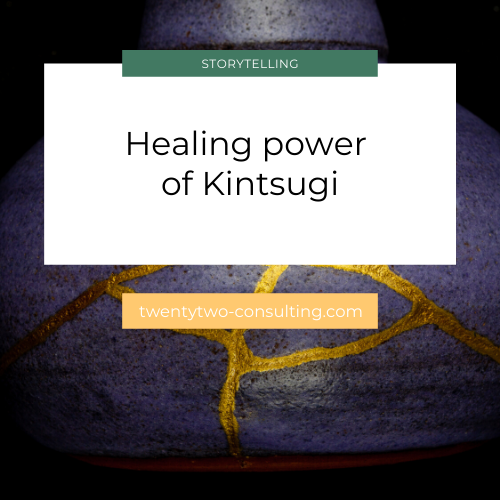Kintsugi is the centuries-old Japanese art of mending broken pottery with gold. It may also be an apt metaphor for what art therapy can achieve.
The kintsugi technique uses lacquer resin laced with gold to assemble back together the broken pieces of a bowl or a vase. Not only do the cracks become part of the design, but the use of a precious metal such as gold adds beauty to an object which, by the very process it went through, also becomes a unique piece.
This practice is connected to the Japanese philosophy of wabi-sabi which calls us to see beauty in the flawed or imperfect. In Japanese, wabi means alone and sabi stands for the passage of time. Together, they teach you to accept the good and the bad in yourself, as well as life’s fundamental asymmetry. By learning to embrace the flawed, you shift your focus from wanting to reach an ideal to focusing on your strengths.
In essence, kintsugi relies on the idea that what has broken us becomes part of our history and that we can go beyond the destruction to create something new, deserving of attention and even admiration. Practicing kintsugi is an act of resilience.
And this is where it is interesting to draw a parallel between this Japanese art and art therapy itself.
Art therapy as a medium for self-discovery
When practiced with a therapist, art therapy may use techniques such as drawing, painting, collage, and dance, for instance. The idea is to allow the client to explore their feelings, emotions, and experiences as well as to develop coping skills. Clients create and then reflect on their art to analyze the emotions triggered.
There is a whole work of observation and interpretation at play: not only does the client looks at the art, but so does the therapist, who, additionally, also observes the client during the creative process. Ultimately, the client may achieve a level of understanding and self-acceptance. This can be very empowering.
But art therapy does not necessarily have to involve a therapist. It can be something you practice from the comfort of your home. And most importantly, it does not require you to possess any artistic skills. Art therapy can be as simple as grabbing a few pencils, a sheet of paper and starting drawing. Then see where inspiration leads you.
Expressing your feelings, inner thoughts, memories, and experiences through art, any form of art, is what art therapy is about. All of these elements become the parts you are trying to make sense of, assembling them in that understanding of who you are—your mended bowl showing its golden scars, if you will.
Beauty does not matter, healing does
Art therapy does not necessarily create something beautiful, though. It is, first and foremost, an exploration. It can be clumsy. It can even feel uncomfortable. If you naturally tend to be more in your head than in your body but decide to try dance as therapy, you may feel awkward at first, and you may not look graceful. But, because you are pushing yourself through that very process of dancing that may not feel familiar, you can expect to discover new sensations and see yourself and your body in a different light. Art therapy has the potential for revelation. It also favors self-empowerment.
Another example is painting: the colors you choose, the patterns you create, how much you expand on the paper, etc. All this may tell you something about who you are, where your mind is, and how you see life.
You need to approach art therapy with a free mind, though: follow your inspiration, create and then only reflect on the process and the work.
The simple act of taking a brush and spreading paint on the canvas may feel very liberating. If you don’t have any artistic training, it may take you back to your childhood, when you would happily draw and paint with little to no expectations. Forget about the great works of art you have admired in museums and books. Instead, experiment freely, the way a child would. Don’t worry about the result. Enjoy self-expression.
Again, even though that may seem counter-intuitive to some because we are talking about art, beauty is not the objective in art therapy but merely a potential by-product of the artistic process.
Healing is the ultimate goal. Finding a voice to express yourself, getting to know a little more about yourself, and understanding what you can do to progress on your path—feeling empowered to move on.
Why not embark on a journey of art therapy to repair yourself, continue your life journey, and accept yourself with all your golden cracks?
Art therapy is the reason to live of ArtherapyHQ. To learn more about us and join our movement, please visit www.artherapyhq.com.


